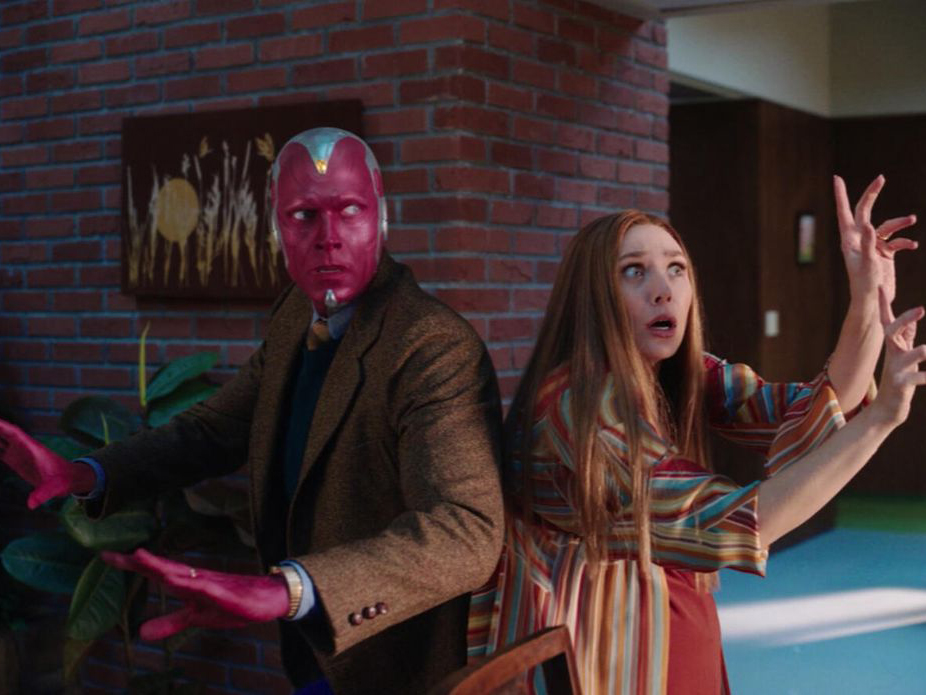
After several ambiguous episodes and much theorizing from the Marvel fandom, “WandaVision” has finally moved the curtain back. The newest episode of “WandaVision” has finally moved away from the sitcom narrative it has dedicated the first three episodes to — which, frankly, was quickly running its course. Episode four, titled “We Interrupt This Program,” is chock full of answers and Marvel easter eggs that do an excellent job in progressing the show past the emptiness of the sitcom style and furthers the worldbuilding of a post-Infinity Saga Marvel.
Marvel has gone through various changes over the past decade as it has moved from Phase One to Phase Three. Phase One movies like “Iron Man” (2008) were based mostly in action with minimal character development; Phase Two moved away from solely telling standalone hero stories to ensemble epics with movies like “Avengers: Age of Ultron” (2015), indicating a wider universe. Phase Three furthered that goal, exploring what the Avengers are like when faced with the bleakest odds. “WandaVision” is part of Phase Four, and so far it is doing a good job of exploring an individual Avenger’s psyche in a way that other superhero movies have not done before. In this Disney+ original, Wanda (Elizabeth Olsen) is not facing a battle or a villain — she’s facing her own grief.
Episode four spends the majority of its 30 minute runtime in the aftermath of the Marvel “blip” as Monica Rambeau (Teyonah Parris), who we last saw decades younger in “Captain Marvel,” awakens to a chaotic hospital. People who disintegrated five years earlier are suddenly reassembling back into humans into a transformed world. This is the first time besides “Spiderman: Far From Home” that the audience is seeing how the world grappled with the return of the people who were lost to Thanos’ snap. People scramble around the hospital in an attempt to call their loved ones; in Monica’s case, she’s trying to find her mom, Maria Rambeau, who died in the five years she was gone. Only weeks later, she’s back at work and has to see her colleague in a position that she implies would’ve been hers had she not been part of the snap. Seeing these sorts of interactions makes the viewer become invested in the world instead of just caring about the characters, a task that will surely help Marvel as they move into Phase Four.
FBI Agent Jimmy Woo (Randall Park) makes an appearance in this episode as one of the many agents investigating why a town that no one has heard of has suddenly popped into existence. After Monica’s agency, Sentient Weapon Observation Response Division (S.W.O.R.D) sends her to examine the scene, and she is pulled into the energy field surrounding the town of Westview. Everyone remains baffled until Monica is expelled from the town after Wanda realizes she is not part of the set she’s created. The show picks up from the end of episode three as Monica says, “It’s all Wanda.”
Out of the many theories, one has surfaced above the others: Wanda is not being held hostage by Hydra; she is simply a prisoner of her own grief. The implication itself creates a saddening but realistic portrayal of how everyone — even Avengers — are vulnerable to the psychological damages of war and death. Wanda lost the love of her life, the person who she was setting herself up to be with for the rest of her existence; it is a loss none of the other Avengers really endured. Most characters returned (albeit in younger versions) or did not have a profound connection with anyone the way Wanda did. Worse, she was forced to kill Vision (Paul Bettany) herself in order to save the rest of the universe, a task that ultimately proved futile and painful when Thanos used an Infinity Stone to turn back time and crush Vision’s skull himself. Wanda has a near debilitating episode of post-traumatic stress disorder in “We Interrupt This Program” when she sees Vision not as the vibrant crimson of his former self but a lifeless gray husk of metal with a missing chunk in his head. Throughout, Wanda has been attempting to keep her perfect life in place by rewinding and rewriting reality or expelling characters that don’t fit in with the idea of picturesque domesticity that she has created. This episode explores the limits of her power.
Verdict: “WandaVision” makes a good move by replacing the hollow sitcom style storylines and vague clues with a view into the post-snap Marvel world. In an episode filled with Easter eggs and answers, the audience finally watches Wanda’s power be stretched to its limit, ensuring an enthralling watch next week.







